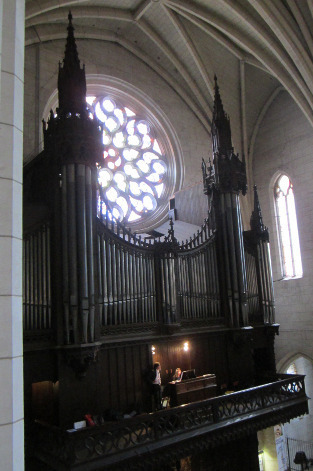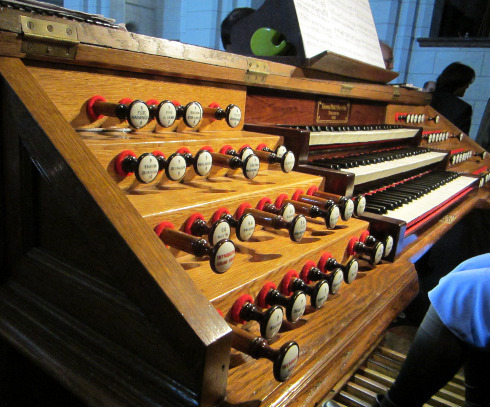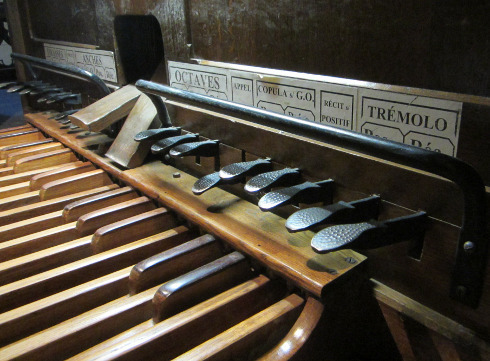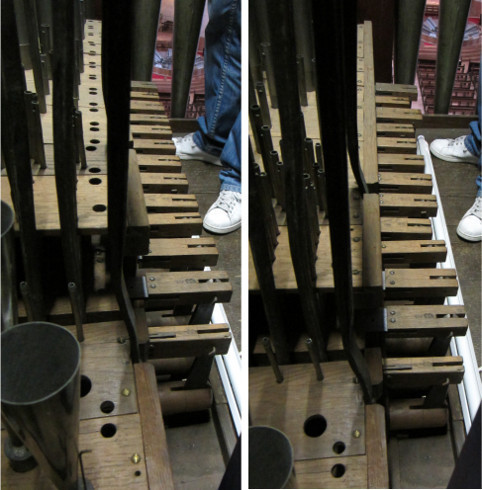The organ of Eglise Notre-Dame La Dalbade – Part II
PART TWO
Again, there was somebody practicing at the keyboards as we wandered up the center aisle. There were very few people there – maybe a half dozen at first, though there were perhaps as many as fifteen or twenty by the time we left. Shortly after we sat down in the pews, a man came down, asking if we were here for the organ? We were. Were we organists? No… Ah well, come on up anyway.

The organ. Unfortunately the best picture I got was crooked.
Initially, after climbing the twisty wooden steps to the level of the organ loft †, we were led into the galleries along the right (as you face the altar) side of the church. The organist, a young woman from Japan, played an arrangement of a CPE Bach cantata (I think). The acoustics of this spot were different from where we had been on the floor of the church and the difference in how the echoes reflected back to us was audible. I also was able to see the stained glass windows around the church better from this elevated viewpoint, and noticed some of the little carvings at the tops of the columns and other details that had not been visible from ground level.

View from galleries.
After the Bach, our little group was then treated to an informal couple of hours of playing, demonstration, and explanations by the professional organist, Mr. de Miguel (the instructor I’d seen up there the day before) and a young man who we believe to be an apprentice organ builder. Unfortunately, my French was unequal to the task of comprehending everything that was said, but even the 1/3 – 1/2 that I understood was extremely interesting. Anything I get wrong is entirely due to the fact that I know almost nothing about pipe organs to start with, the men who explained things talked really fast, and my understanding of French is as yet rather imperfect. Many thanks to boyfriend, who, as a native of this country actually understood most of it, and was later able to explain things to me that I didn’t quite follow at the time.

The pipes from the organ loft.
Eugène Puget, the second of four generations of organ-builders in Toulouse, built this organ, which was inaugurated in 1888. Its most recent restoration, about two years ago, was due to damage during the droughts and heat of 2004, and cost more than €500,000. It is apparently unusually playable, having a relatively light action ††. There are three manuals, a pedalboard and fifty stops, each labeled with a different instrument and pipe length. It also has the ability to control dynamics and has a number of “effects” pedals which affect the tonal quality of the instrument. These features provide this organ an extremely versatile range of tones and colors, and allow for everything from a simple, pure sound to a fully symphonic sound.

The keyboards and stops.

The pedals. The flat wood pedals in the center above the keyboard pedals control volume. The metal pedals on either side control other effects.
An electric air generator now replaces the original man-powered bellows, forcing air up toward the organ’s pipes continuously. When all the stops are in, airflow to the pipes is blocked, and no sound emerges if you press a key. When a stop is pulled out, a particular “instrument” is activated, and air flows to the pipe corresponding to the key pressed by opening a hole by means of some really very clever mechanics. The more stops are opened, the more “instruments” sound when a key is pressed. As I understand it, each manual corresponds to some of the stops, and you can hook things up so one manual controls more than one manual’s worth of stops†††.

Stops in and out.
The current organ has been modified from its original design. At one time, there was a small organ that was in the same location as the keyboards. This is a holdover from a time when organs actually were portable instruments! ‡ The pipes associated with this organ have since been moved inside the main instrument, and are surrounded by a series of vertical levered wooden slats which can be opened and closed by means of two foot-pedals to control the volume of the sound produced.
* * *
† The floor of the loft trembled slightly as people moved around. I found this somewhat alarming at first, though I did get used to it. Being a Californian by upbringing, all I have to say is, thank goodness they don’t seem to get earthquakes around here. Most of the city would be rubble.
†† Mr. de Miguel, the organist, mentioned another organ in town (I think this one) that is very difficult to play due to the heaviness of the keys, which is related to the mechanism that transmits the key movement to the air-opening-bit of the organ.
††† It’s rather odd to watch someone playing on one manual (or the pedals) and seeing other keys on the other manuals moving simultaneously).
‡ From poser (to place), it is called the “positif.” Again according to the website above, the positif of this organ is mostly what’s left of the Moitessier organ.
Stay tuned for Part III, coming soon to a screen near you. –ed
Robin McKinley's Blog
- Robin McKinley's profile
- 7240 followers



